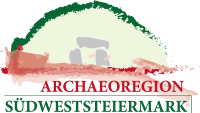
Lethkogel hill, located not far from Stainz, is one of the most important hilltop settlements in western Styria. Archaeological research excavations in the years 2004-2006 proved early copper-age and late Latène-age as well as early medieval usages. The archaeological findings and the find material are of importance beyond the borders of Styria.
The Lethkogel (608 m a.s.l.) in the cadastral commune of Gamsgebirg forms a steeply sloping knoll on the eastern foothills of the Koralpe and lies about three kilometers southwest of Stainz. It rises about 270 m above the valley floor of the Stainzbach river valley and has a settlement area of about 1.2 hectares. The wooded hilltop of the Lethkogel carries a lookout tower, the so-called Stainzer Warte, and offers excellent sight lines to large parts of Central Styria, including such important hilltop settlements as the Burgstallkogel hill near Kleinklein or the Königsberg hill near Tieschen. The microclimatic conditions and the favorable geographic location towards Carinthia were certainly decisive for the settlement activity on the Lethkogel.
Terraces on the north side and the remains of a fortification on the south side of the hill are clear evidence of man-made changes to the terrain. Archaeological research excavations in the years 2004-2006 by the association Archäologieland Steiermark (Wolfgang Artner) prove a hilltop settlement already in the early Copper Age (4000 to 3600 B.C.), which was fortified in the late Latène period (late Iron Age, ca. 130 B.C. to the birth of Christ) and used again in the early Middle Ages.
In the early Copper Age, the Lethkogel may have been a central site in western Styria. The ceramic finds and stone artifacts (e.g. blades, knives or arrowheads) from the Lethkogel are of great importance for this period. The finds point to far-reaching, partly transalpine relations to Carinthia, Slovenia, southwestern Hungary and Upper Austria. The oldest finds – such as pottery fragments of decorated jugs, carinated bowls or spout spoons – date back to the Lasinja culture. Equally remarkable is the find material from the chronologically following furrow-stitch ceramic horizon characterized by a new decorative style of pottery as well as plate silex knives and pottery of the so-called Mondsee group with typical sun and zipper patterns. One of the most outstanding finds from the Lethkogel is a so-called Pintadera, a kind of stamp made of pottery, for which the few comparative specimens from Central Europe show a dispersion from Upper Italy via Hungary to Slovakia.
Fragments of several cast spoons prove that copper metallurgy (arsenic copper) was practiced at the Lethkogel – the earliest evidence of the use of this technology in Styria. At the fringes of the Copper Age settlement, a workshop was uncovered, from which both chipping tools made of silex (a type of flint) and blanks of axes and hatchets are available.
A few fragments of pottery indicate a use of the hill in the Cham Culture (Middle Copper Age, about 3000 B.C.).
The occupation of the Lethkogel is likely to have been limited to the uppermost plateau during the Copper Age, while Late Latène pottery is found over the entire area. The Late Latène period includes the Late Celtic fortification wall on the southern side of the Lethkogel which was archaeologically investigated in 2006. It can be traced over a length of about 100 m and was preserved at the excavation site at a height of almost two meters. At the base, the sectional fortification had a width of five meters, its construction method – among other things with a screen wall at the front, stabilizing wooden constructions and a ramp on the uphill side reinforced with stone cross ties – was extremely elaborate. Also dating to the late Latène period are numerous ovens of still unexplained function that were uncovered on the northwestern slope outside the sectional fortification.
The early medieval find material from the Lethkogel is limited to scattered pottery fragments of the 8th and 9th, perhaps the 10th centuries. Possibly the last fortification phase of the Lethkogel dates to the Early Middle Ages. This is indicated by a v-shaped ditch with a dry wall in front of it, which was dug into the Late Latène fortification.
The deposition of two intact ceramic pots, which had been placed separately in two shallow, slightly oval pits, also dates from the Early Middle Ages. No further finds or features were found. Excavator Wolfgang Artner attaches a cultic-religious interpretation to this finding; it could be afterbirth pots.
These early medieval settlement traces, which are difficult to classify, represent the end of the settlement of the Lethkogel, whose archaeological research made possible new insights into Styrian history.
Text: Mag. Dr. Wolfgang Artner

